How To Use Data In Marketing?
Insights From Industry Leaders
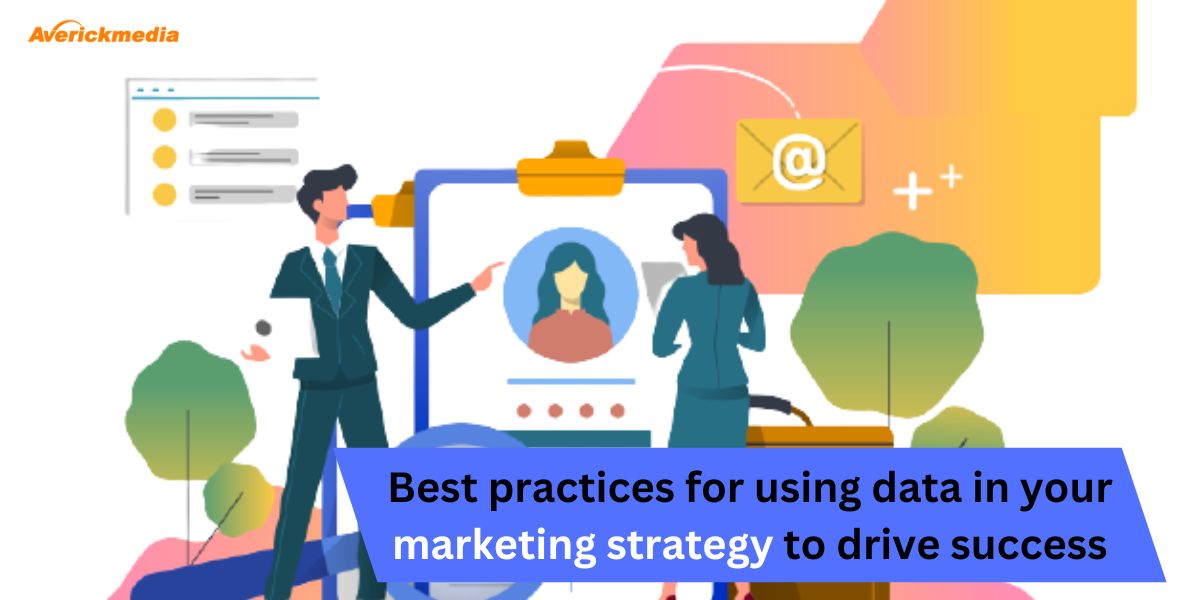
Successfully steering a thriving enterprise in the present day requires gathering data for analysis to gain a deeper understanding of both the business and its patrons. Companies like Amazon, Google, and Airbnb have been utilizing data as a tool for their business endeavors for a long time. However, the progression in data processing and visualization has spotlighted the worth of data and has made it easier for everyone to harness the power of big data.
But "What is Data? "Business Data encompasses all the information associated with a company's performance, operations, and customer feedback including executives details working in that company. This includes a wide range of data, from product/service details, sales and marketing statistics, customer feedback, raw analytics data, and more.
Send a message to our sales team below
Table of Content :
- Importance Of Understanding Data Usage In Marketing: The Vital Role Of Data In Marketing Success
- Exploring the Data Landscape: A Guide to the Data Ecosystem in Marketing
- The Vital Importance of the Marketing Data Ecosystem
- Learning from the Best: Insider Insights on Data-Driven Marketing from Industry Leaders
- How to use Data: Top 5 Best Practices Shared by Industry Leaders
- Are Mailing Lists Still Relevant? Industry Leaders Weigh in on the Use of Mailing Lists in Marketing
- From Theory to Practice: Real-World Case Studies in Data-Driven Marketing Success
- Case Study 1 - Data-Fueled Dominance: How Amazon Used Data to Become the World's Leading E-Commerce Platform
- Case Study 2 - From Startup to Sensation: The Rapid Rise of Airbnb to a $100 Billion Valuation in 5 Years
- The Evolving Landscape of Data-Driven Marketing in the Future
- So Are You Convinced To Use Data In Your Marketing?
Companies gather as much data as they can to optimize their operations and gain deeper insight into customer preferences, allowing them to deliver better customer experiences. As organizations move online, data has become a critical resource. Marketing Data can serve as the foundation for an organization's customer service activities, allowing it to understand more about consumer needs, complaints, and business operations. Understanding data in business can help you grasp how modern businesses use it to succeed.
As a result, in this blog, we will explore the importance of data in marketing and provide insights from industry leaders on the best practices for utilizing data. From understanding the customer to personalization and measurement, we'll delve into the various ways data can be used to drive marketing success. Additionally, we'll examine the future of data-driven marketing and provide recommendations for marketers looking to embrace data in their marketing strategy.
So, whether you're a seasoned marketer or just starting out, this blog will give you a comprehensive overview of the role of data in modern marketing and help you develop a data-driven marketing strategy.So let's get started.
Importance Of Understanding Data Usage In Marketing: The Vital Role Of Data In Marketing Success
Data is a crucial tool for organizations in the twenty-first century. Clive Humby, a British mathematician, coined the phrase "data is the new oil" in 2006 to describe the availability of both resources: neither oil nor data is valuable in their initial form; rather, value is obtained when it is gathered completely, and accurately, and is linked to other relevant data.
According to a Forbes article about a Deloitte survey, "49% of respondents said analytics helps them make better decisions, 16% say it better facilitates major strategic goals, and 10% say it helps them enhance relationships with both customers and business partners." However, in order to fully benefit from data and analytics, you must understand how to extract the most value from your data.
So, what does that really mean? Here are five ways data may assist businesses of all kinds, particularly SMBs.
Industry-Specific Email Lists
- Financial Services Email List
- Manufacturing Industry Email List
- Automotive Mailing Lists
- Retail Industry Email List
- Oil and Gas Mailing List
- Pharmaceutical Email Lists
- Transportation Mailing List
- Construction Industry Email List
- Education Industry Email List
- Food and Beverage Email List
- Hospitality Email List
Send a message to our sales team below
1. Data Helps Businesses Make Informed-Decisions

One of the most compelling reasons for organizations to collect data is that it can help them make better decisions. According to 64% of marketing executives, Data-driven initiatives are important in today's economy. Decisiveness can be a beneficial trait for a business because it allows them to make difficult decisions more quickly and understand the consequences or benefits of those decisions. For example, if a firm wishes to enter a new market, gathering data is essential because the company has to know how the market operates, where it might fit into that market, and what types of clients it might service once there.
2. Troubleshooting Marketing Problems

When sales are down, or a product fails, how do you determine the root cause? Data allows firms to monitor and assess the health of various business processes and critical systems. This can be understood in two ways: 1) hindsight and 2) foresight.
In hindsight, Businesses can evaluate data to identify stages where performance breakdowns occur. They can apply appropriate strategies to improve such stages if they understand where the processes or systems are failing. In foresight, because data enables businesses to monitor the health of multiple systems and processes, organizations may effectively impose quality monitoring, allowing them to respond to difficulties before they become major issues.You can utilize a variety of techniques to tackle real-world problems, and the relevance of data can be shown in the variety of techniques you can take.
3. Streamlining Company Processes

Data can help streamline company processes by showing leaders how efficient or pricey specific processes are. With this information, firm management may evaluate how to improve operations such as manufacturing and customer service. For example, a company may collect marketing data and discover that it is investing 50% of its marketing budget in social media initiatives that aren't generating qualified leads. With this information, the corporation may decide whether to withdraw cash from that approach and reallocate it elsewhere for a higher return on investment and ongoing financial savings. In fact, according to Forbes," Data is one of the most effective ways to reduce costs and increase profits."
4. Data Helps You See Performance

Have you ever questioned the effectiveness of your team, department, company, marketing strategies, customer service, shipping, or other aspects of your business? Collecting and analyzing data can give you a clear understanding of their performance and more. Without this information, it can be difficult to determine if your employees or marketing efforts are generating a positive return on investment. For instance, imagine you're directing most leads to your top-performing sales representative, but data reveals that they close deals at a lower rate compared to another representative who has a higher closing rate, despite receiving fewer leads. Having this performance data can influence how you distribute leads and ultimately drive revenue growth. Performance data provides the clarity necessary for improved results.
5. Increases Revenue And Profits

Data can also help a firm grow revenue and profits by making it more efficient, providing critical insights into operations and customer satisfaction, and assisting in the improvement of certain procedures. Data can assist organizations in determining whether certain actions, products, or services are lucrative and where their biggest expenses may be. Identifying expenses is frequently the key to growing profits since firms can cut those expenses and keep more of the income they receive by identifying those expenses. Raw data assists the organization in determining where it may save costs, increase efforts, and generate more income.
Exploring the Data Landscape: A Guide to the Data Ecosystem in Marketing
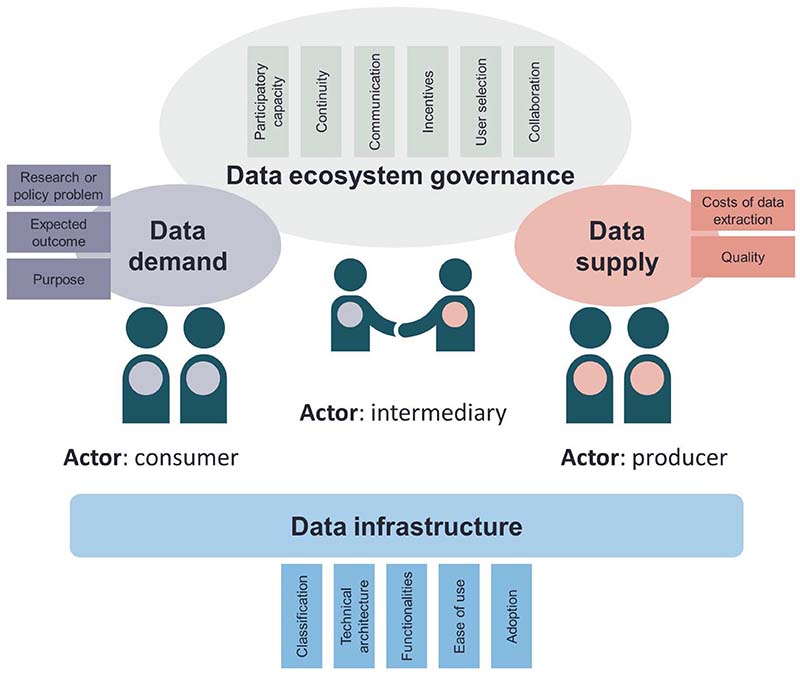
The data ecosystem refers to the complete system of data generation, storage, processing, analysis, and dissemination of information. It encompasses various components such as data sources and management (storage systems, data processing tools, data analytics techniques, and data visualization tools). The goal of a data ecosystem is to ensure the efficient and effective flow of data within an organization to support informed decision-making and drive business outcomes.
Below is a detailed explanation of each component to help 'YOU' make better decisions.
1. Data Sources
Data sources refer to the origin or location of the data that is being collected and analyzed. They can be either internal (within the organization) or external (outside the organization). Simply put, data sources can be a database, a flat file, live measurements from physical equipment, scraped online data, or any of the numerous static and streaming data services available on the internet. The goal is to package connection information in a more understandable and user-friendly style. This is crucial considering that it needs to integrate easily into different systems, relieving stockholders of the need to deal with and troubleshoot complex yet low-level connection information.
Healthcare Email Contacts
Send a message to our sales team below
Examples of Internal Sources:
Transactional Systems are computerized systems that process and manage transactions, typically in real-time. They are used to record and manage various types of business transactions, such as sales, purchases, and financial transactions. These are later recorded in a database and can be used to update a company's financial records and support decision-making. This type of data assists organizations in understanding what customers buy, when they buy it, what stages they take in the process, and more. Examples of transactional systems include point-of-sale (POS) systems,CRMsystems, and ERPsystems.
Internal Databases are data storage systems that are owned and maintained by an organization. They are used to store large amounts of structured and semi-structured data generated by the organization's activities and operations. Internal databases can be either relational databases, where data is organized into tables with rows and columns, or NoSQL databases, which can handle unstructured or semi-structured data. Examples of internal databases include Microsoft SQL Server, Oracle, and MongoDB. Internal databases play a critical role in the data ecosystem by providing a centralized repository for storing data and enabling access to this data for various applications and analytics tools within the organization.
Examples of External Data Sources:
Government Statistics are numerical data collected and published by government agencies to share information about the state of a country or a particular sector of the economy. These statistics can cover a wide range of topics, such as population demographics, economic indicators, health outcomes, crime rates, and education attainment. Government statistics are widely used by researchers, analysts, businesses, and policymakers to inform decision-making and understand societal trends and patterns.
Some common examples of government statistics include the Bureau of Labor Statistics, the United States Census Bureau, and the National Center for Health Statistics. Government statistics are usually considered a reliable and trustworthy data source due to the rigorous methods used to collect and analyze the data and the impartiality of the agencies responsible for collecting and publishing the data.
Social Media Platforms generate extensive amounts of data, including text, images, videos, and metadata, that can provide valuable insights into consumer behavior, sentiment, and opinions. This data can be used by businesses, researchers, and analysts to inform marketing and advertising strategies, monitor brand reputation, and study consumer trends and patterns. However, the accuracy and reliability of data from social media platforms can vary and may be subject to bias and manipulation, so it is important to carefully evaluate and validate this data before using it for decision-making and analysis.
2. Data Management
Data management is the process of collecting, storing, processing, and analyzing data to support and drive better business outcomes. As organizations generate and consume data at unprecedented rates, data management solutions become critical for making sense of massive amounts of data. Today, data management performs numerous roles within an organization, making key operations easier and less time-consuming.
Data Collection

Source: QuestionPro
Data collection is a critical step in the data management process, as it determines the quality and accuracy of the data that will be used for analysis and decision-making. Data collection can be done through various methods, including manual techniques like surveys and automated techniques like web scraping. The method chosen for data collection will depend on the specific requirements of the data, such as the volume and complexity of the data, as well as the resources available for data collection. Ultimately, the goal of data collection is to gather accurate, complete, and relevant data that can be used to support informed decision-making.
Storage Systems
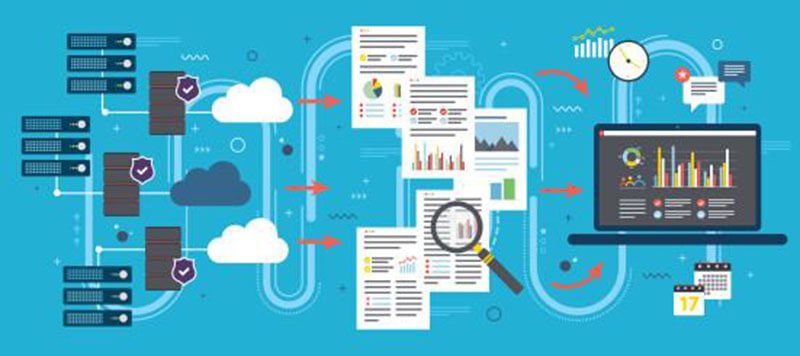
If the Data ecosystem is a house, the Storage system is the foundation. Data storage plays a key role in the success of data management by providing a secure and organized repository for collected data. The process of data storage requires careful consideration of factors such as the volume, variety, and velocity of the data, as well as the specific needs of the organization. The data can be stored in a range of systems, including internal databases, cloud storage solutions, or specialized data warehouses. The choice of storage system will depend on these factors and the organization's unique requirements, including data security, accessibility, and scalability. Proper data storage not only protects the data but also enables efficient retrieval and use of the data for analysis and decision-making.
Data Processing Tools
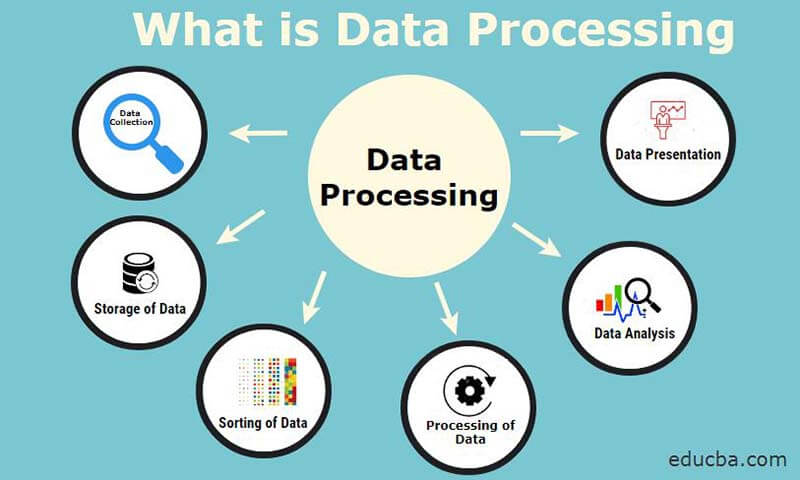
Source: educba
Data processing is an essential component of data management, transforming raw data into actionable information that can be used to support informed decision-making. This process takes raw data and prepares it for analysis, often involving several steps such as cleaning, transforming, and pre-processing. Data processing can be performed using a variety of tools and techniques, such as data integration tools to combine data from multiple sources, data quality tools to ensure accuracy and completeness, and data manipulation and transformation tools to reshape and format the data into a usable format. The use of these tools not only streamlines the data processing process but also helps to improve the accuracy and reliability of the resulting data.
Data Analysis
Data analysis is the ultimate destination of the data management journey, where the transformed and processed data is put to work to drive better decision-making. It's a process of exploring, evaluating, and drawing insights from data to uncover hidden patterns, trends, and relationships.Data analysis can take many forms, from exploratory data analysis that gives a preliminary understanding of the data, to statistical analysis for testing hypotheses and determining relationships, to predictive modeling for forecasting future outcomes. The specific approach to data analysis will depend on the specific problem or question being addressed.
Data analysis is performed using a variety of tools, including spreadsheets, statistical software, and machine learning algorithms. These tools allow data analysts to perform complex analyses and uncover valuable insights from the data.
Data Visualization Tools
Data visualization tools are software applications that allow users to represent data in a graphical or pictorial format, making it easier to understand and communicate. They provide a visual representation of data that can highlight patterns, trends, and relationships that might not be immediately apparent in a raw data format. Data visualization tools can also help to identify outliers and anomalies in the data, which can be important in identifying problems and opportunities.
Industry-Specific Email Lists
- Financial Services Email List
- Manufacturing Industry Email List
- Automotive Mailing Lists
- Retail Industry Email List
- Oil and Gas Mailing List
- Pharmaceutical Email Lists
- Transportation Mailing List
- Construction Industry Email List
- Education Industry Email List
- Food and Beverage Email List
- Hospitality Email List
Send a message to our sales team below
The Vital Importance of the Marketing Data Ecosystem
The data ecosystem is a complex and interconnected system of data sources, data management processes, and data analysis tools that work together to support decision-making and inform business strategy. It is a critical component of organizations in today's data-driven world, and its importance cannot be overstated.Consider the recent SolarWinds incident, which has been described as one of the worst security breaches in history.
SolarWinds is an information technology company that creates network management software that is used by over 30,000 client corporations and organizations.In early 2020, hackers introduced harmful code into SolarWinds' software, which was subsequently disseminated to clients via updates. As a result, hackers gained access to the data of thousands of firms and organizations, including NASA, the Federal Aviation Administration, and other government institutions. By knowing how each component of your organization's data ecosystem interacts with other components, you may prepare for these types of difficulties and uncover possibilities for efficiency.
The importance of the data ecosystem can be seen in the following ways:
- Better decision-making: The data ecosystem provides access to the data needed to inform decision-making and support evidence-based decision-making.
- Increased efficiency: Data management processes and tools streamline the handling of data, making it easier to access and analyze data, which can lead to increased efficiency and productivity.
- Improved accuracy: By collecting, storing, processing, and analyzing data in a consistent and standardized manner, the data ecosystem helps to ensure the accuracy of the data and reduce the risk of errors.
- Enhanced insights: The data ecosystem provides the tools and techniques necessary to uncover insights and relationships in data, helping organizations to make more informed decisions and stay ahead of the competition.
- Better risk management: By providing access to accurate and complete data, the data ecosystem can help organizations to identify and manage risk more effectively. This is because each component of the data ecosystem interacts with and influences the others, which means that if a business isn't attentive, it might pose data integrity, privacy, and security issues.
Industry-Specific Email Lists
- Financial Services Email List
- Manufacturing Industry Email List
- Automotive Mailing Lists
- Retail Industry Email List
- Oil and Gas Mailing List
- Pharmaceutical Email Lists
- Transportation Mailing List
- Construction Industry Email List
- Education Industry Email List
- Food and Beverage Email List
- Hospitality Email List
Send a message to our sales team below
Learning from the Best: Insider Insights on Data-Driven Marketing from Industry Leaders

What do the industry leaders say about 'Data' and its application in marketing? Let’s take a look at some insights shared by several industry leaders:
1. Rand Fishkin, Founder of SparkToro: "Marketers must embrace data and embrace the importance of understanding their audience. Without that foundation, all the tactics and strategies in the world will fall short."
2. Avinash Kaushik, Digital Marketing Evangelist at Google: "Data is the lifeblood of all successful marketing campaigns. It helps marketers to understand the behavior and needs of their target audience and make informed decisions about their campaigns."
3. Brian Dean, Founder of Backlinko: "Data-driven marketing is about using data to make informed decisions, instead of relying on intuition or guesswork. By analyzing data, you can optimize your campaigns, make better use of your resources, and achieve better results."
4. Neil Patel, Founder of Neil Patel Digital: "Marketing is all about reaching the right people, with the right message, at the right time. Data helps you to do just that. By using data to understand your audience and target them effectively, you can achieve better results and ROI.”
Why do these insights matter? Industry-leading professionals are recognized as experts and leaders in their respective fields. These individuals have a deep understanding of their industries, and their insights are based on their experience, expertise, and knowledge. They can provide valuable insights into the current state of the industry, its future direction, the challenges and opportunities it faces, and the best practices for success. Their insights are important because they offer a unique perspective on the industry and can provide guidance and inspiration to others who are looking to succeed in the same field.
Some advantages include the following:
- Experience: Industry leaders have years of experience in their respective fields and deeply understand the challenges and opportunities. Their insights and advice are based on this wealth of experience and can help others to navigate the complexities of their industry.
- Expertise: Industry leaders are recognized experts in their fields and have a thorough understanding of the latest trends, techniques, and technologies. Their insights can help others to stay up-to-date with the latest developments and best practices.
- Credibility: Industry leaders are recognized and respected in their industries, and their opinions are often seen as authoritative. This makes their insights valuable for others who are seeking to gain credibility and establish themselves as leaders in their fields.
- Inspiration: Industry leaders can inspire others with their stories of success, innovation, and determination. Their insights can motivate others to pursue their own goals and overcome the challenges they face.
How to use Data: Top 5 Best Practices Shared by Industry Leaders
Industry leaders in the marketing field have a wealth of knowledge and experience in using data to drive marketing success. Here are 5 best practices that every industry leader recommends:
1. Understanding the Customer
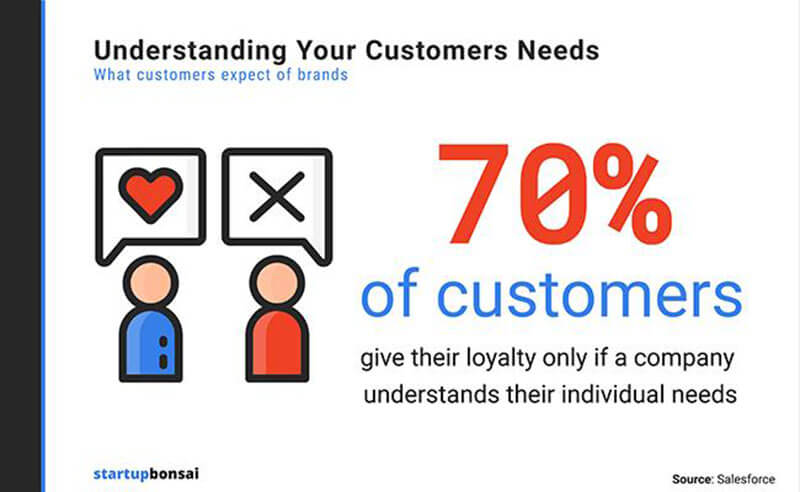
Source: startup Bonsai
Industry leaders emphasize the importance of understanding the customer to inform marketing decisions.Understanding the customer is the foundation of data-driven marketing. This involves collecting and analyzing data on customers’behavior, preferences, and demographics to gain insights into what motivates them to buy. This data can be collected through various sources, such as transactional systems, customer relationship management systems, and social media platforms. With this information, businesses can tailor their marketing efforts to meet the specific needs and wants of their customers, ultimately resulting in more effective marketing campaigns and increased customer satisfaction.
2. Segmentation and Targeting

Source: Efficy
Did you know that 77% of marketing ROI comes from segmented and targeted campaigns and that 85% of product launches fail due to poor segmentation? Segmentation and targeting are important practices, according to industry leaders. Segmentation involves dividing a large customer base into different groups based on characteristics such as demographics, behavior, or interests. Targeting involves using this segmented data to create tailored marketing campaigns for each segment. This can result in higher engagement and better conversion rates. In fact, according to reports, you can see a conversion rate as high as 200%.
3. Personalization

Source: Outgrow
Industry leaders encourage organizations to use data to personalize customer experiences and to create targeted and relevant marketing campaigns. This can involve using data to personalize email campaigns, web pages, and other marketing materials. Personalization, according to 98% of marketers, is highly effective.
4. Measurement and Attribution
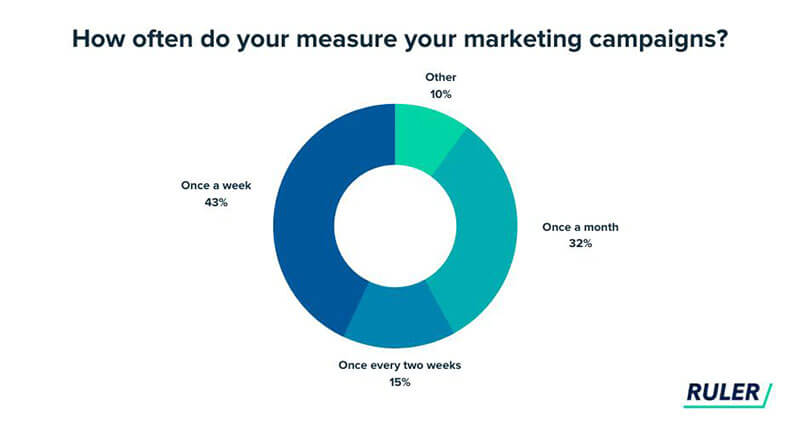
Source: Ruler
Industry leaders often urge organizations, both large and small, to continuously measure the results of marketing campaigns and make adjustments as needed. Data can provide valuable insights into what is working and what is not, allowing organizations to make informed decisions about future campaigns. According to 43% of marketers, businesses must measure their campaign once a week.
Attribution, on the other hand, is the process of assigning value to marketing efforts, such as attributing a sale to a specific marketing campaign. By measuring and attributing the impact of marketing efforts, organizations can make data-driven decisions about future campaigns.
5. Data Privacy and Security
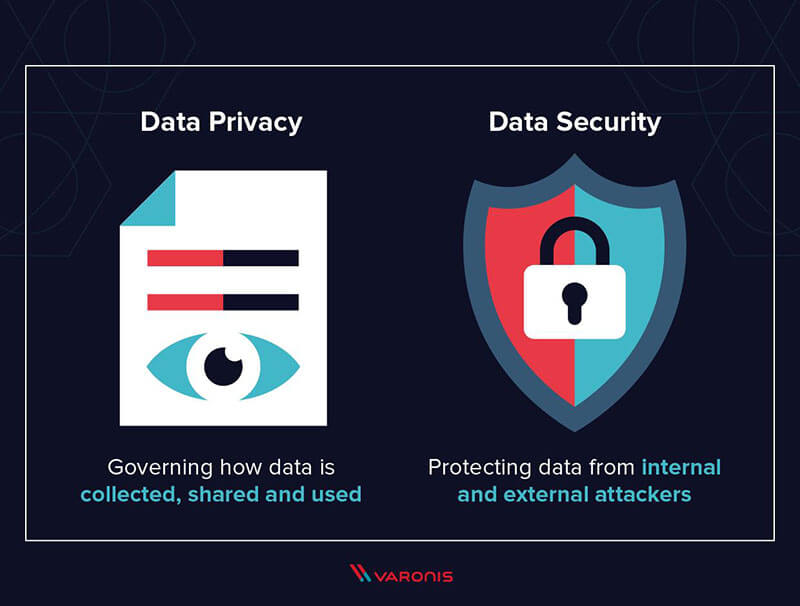
Source: Varonis
Industry leaders also emphasize the importance of data privacy and security. With the growing amount of data being collected and stored, it is crucial that organizations have robust data privacy and security policies in place to protect the sensitive information of their customers. In fact, according to reports, 76% of users believe companies must do more to protect their data online. This calls for adopting new technologies such as encryption technologies, secure data storage systems, and regularly auditing and testing data security measures.
Email Lists by Industry
| Industry Databases | Total Records |
|---|---|
| Automotive Leads | 184,549 |
| Banks & Finance Leads | 362,687 |
| Construction Leads | 437,672 |
| Education Leads | 673,967 |
| Food & Beverage Leads | 195,317 |
| Hospital/Clinic Emails | 579,362 |
| Industry Databases | Total Records |
|---|---|
| Healthcare Leads | 3.2M+ |
| Manufacturing Leads | 548,081 |
| Oil and Gas Leads | 129,357 |
| Real Estate Leads | 284,120 |
| Education Industry Leads | 673,967 |
| Mining Industry Leads | 156,713 |
Are Mailing Lists Still Relevant? Industry Leaders Weigh in on the Use of Mailing Lists in Marketing
The relevance of mailing lists in marketing continues to be a topic of debate among industry leaders. Some believe that email lists are still an important tool in a marketer's arsenal, while others argue that they have been largely replaced by more modern marketing approaches.
Those who support the use of
But email marketing lists argue that they offer a direct and personal way to reach customers. By sending targeted and relevant messages to a customer's both physical and digital mailbox, marketers can create a deeper connection with the customer and build brand loyalty. Additionally, email address lists can be a cost-effective way to reach customers, particularly for small businesses with limited marketing budgets.
But what is a mailing list? A mailing list is a database containing the email addresses of working individuals associated with different businesses, including healthcare, manufacturing, automotive, and more. B2B Email List is typically used by companies that offer products or services related to such businesses for the purpose of marketing and outreach. The list of emails can be purchased or obtained through various sources. The list allows marketers to execute campaigns targeted at email subscribers to share the latest offers, news, upcoming events, etc.Along with email addresses, the contact list can include names, locations, services opted for, products purchased, gender, etc.By having a specific list of email addresses of individuals associated with targeted industries, businesses and organizations can reach their desired target audience more effectively.
Job Title / Role Specific List
Send a message to our sales team below
Business lists are typically used to send targeted messages to your desired audience via various marketing channels such as email, direct mail, telephone, social media, and more. The list can be very beneficial for an organization as it provides several benefits such as direct connection, wider audience, Lower cost per lead, ownership of the list, targeted emails, etc.
However, many of you might be confused about the types of mailing lists and what suits your business. Simply put, there are 7 types of mailing lists that industry leaders recommend you create and segment.
1. House List: A house list is a mailing list composed of current and past customers and leads generated through various marketing efforts.
2. Rent List: A rent list is a mailing list that is rented from a third-party provider for a fee. The provider may have compiled the list from publicly available information, such as phone directories and voter registration data.
3. Compiled List: A compiled list is a mailing list that a third-party provider compiles from various sources, such as magazine subscriptions, warranty card registrations, and product purchase data.
4. Co-Op List: A co-op list is a mailing list that is shared between multiple companies in the same industry or with a similar target audience.
5. Demographic List: A demographic list is segmented based on specific demographic information, such as age, income, and education level.
6. Response List: It includes the individuals who have responded to an offer in some fashion. These are clients that have expressed an interest in a specific product or service.
7. Behavioral List: A behavioral list is a mailing list that is segmented based on specific behaviors, such as product purchases or website visits.
Each type of mailing list has its own strengths and weaknesses, and the selection of which type to use will depend on the specific requirements of the marketing campaign.
So what do the industry leaders recommend? The relevance of email databases in marketing continues to be a topic of discussion among industry leaders. However, many believe that marketing lists are still an important tool for reaching customers, especially for businesses that have a loyal and engaged customer base. Data provided in an email list encompasses all demographic, firmographics, and technographic data that companies cannot overlook. It is simply too convenient and productive for businesses looking to expand in an entirely new market. Although it may have some implications, such as data privacy, accuracy, deliverability, legitimacy, etc., it can all be countered with a good data provider.
Overall, the use of a Business database in marketing will depend on the specific goals and target audience of the organization. Some organizations may find that business lists are still a valuable tool in their marketing mix, while others may choose to focus on a more organic way of building a mailing list. It's important for organizations to continually evaluate the effectiveness of their marketing channels and adjust their strategy as needed.
Industry-Specific Email Lists
- Financial Services Email List
- Manufacturing Industry Email List
- Automotive Mailing Lists
- Retail Industry Email List
- Oil and Gas Mailing List
- Pharmaceutical Email Lists
- Transportation Mailing List
- Construction Industry Email List
- Education Industry Email List
- Food and Beverage Email List
- Hospitality Email List
Send a message to our sales team below
From Theory to Practice: Real-World Case Studies in Data-Driven Marketing Success
Data-driven marketing has become an essential part of modern marketing, with businesses of all sizes leveraging data to inform their strategies and drive results. It is important to understand how big companies leverage data to drive their marketing toward success. As a result, we will explore two case studies of companies that have successfully used data-driven marketing to achieve major business success. These case studies highlight the impact that data-driven marketing can have on customer engagement, sales, and overall growth and provide valuable insights and lessons for organizations looking to implement similar strategies. Whether you're anSMB just starting out or a large enterprise looking to stay ahead of the competition, these case studies will give you a glimpse into the potential of data-driven marketing and help you understand how to effectively leverage data in your own marketing efforts.
Case Study 1
Data-Fueled Dominance: How Amazon Used Data to Become the World's Leading E-Commerce Platform

Source: Amazon
We've all heard of Amazon, the world's most powerful e-commerce corporation, with over 197 million MAUs ( monthly active users) worldwide. It is one of the world's most successful e-commerce platforms, and its success can largely be attributed to its data-driven approach to marketing. In 2021, Amazon's share of all e-commerce sales in the U.S. hit a whopping 56.7%, which is by far the greatest for any e-commerce business.By leveraging data and technology, Amazon has gained insights into customer behavior, preferences, and purchase patterns, which helped them make informed marketing decisions and business strategies.
Amazon has grown into other areas as well, such as Amazon Prime and Amazon Web Services (AWS), and has purchased a number of promising startups. Before becoming the best-selling e-commerce site, Amazon began as an online book store. 27 years after its inception, e-commerce is still Amazon's largest source of revenue. Even though AWS is currently the most profitable, pushing the company’s total profit above $10 billion in 2018 and $20 billion in 2020. The key to this power is data.
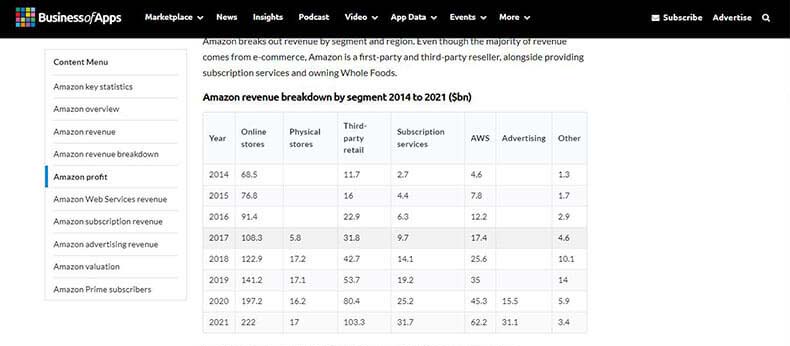
Source: BusinessofApps
Amazon requires the use of data. Every minute, a large number of people enter data into their systems. Amazon constantly collects data and uses it to improve its services. Their recommendation algorithm does more than just suggest similar products. They use the collaborative filtering method to understand one user's preferences by analyzing the profiles of other users who share similar features. Despite 12 million products, Amazon's suggestion algorithm helps us locate what we want or even something we never thought we'd want. This recommendation mechanism undoubtedly accounts for 35% of annual sales.
Another important aspect of Amazon's data-driven approach is its use of personalization. The company uses data to create highly customized shopping experiences for each of its customers, with recommendations, promotions, and product listings tailored to their individual preferences and behavior. This has not only helped to improve the customer experience but has also helped Amazon to increase its sales and profits.
Amazon's data-driven approach has been so successful that it has become a model for other e-commerce businesses to follow. In 2021, the company reported net sales of over $470 billion, making it the world's largest e-commerce platform. Furthermore, its Prime membership program, which provides customers with benefits such as free shipping and access to streaming services, now has over 200 million members globally, with 147 million in the US alone.
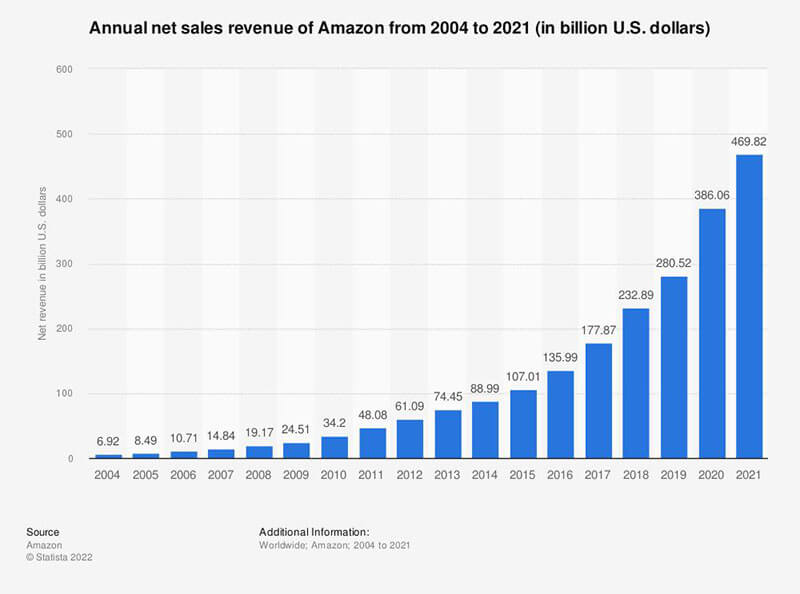
Source: repricerexpress
In conclusion,Amazon uses data in practically every aspect of its business, including supply chain development, pricing, and so on. As a result, Amazon has become one of the world's most successful firms. By leveraging data to understand customer behavior, personalize the shopping experience, and improve the recommendation engine, Amazon has been able to drive sales, increase customer engagement, and maintain its position as the top e-commerce player.
Email Lists by Industry
| Industry Databases | Total Records |
|---|---|
| Automotive Leads | 184,549 |
| Banks & Finance Leads | 362,687 |
| Construction Leads | 437,672 |
| Education Leads | 673,967 |
| Food & Beverage Leads | 195,317 |
| Hospital/Clinic Emails | 579,362 |
| Industry Databases | Total Records |
|---|---|
| Healthcare Leads | 3.2M+ |
| Manufacturing Leads | 548,081 |
| Oil and Gas Leads | 129,357 |
| Real Estate Leads | 284,120 |
| Education Industry Leads | 673,967 |
| Mining Industry Leads | 156,713 |
Case Study 2
From Startup to Sensation: The Rapid Rise of Airbnb to a $100 Billion Valuation in 5 Years

Source: Airbnb
Airbnb is a global online marketplace for people to list and book unique vacation homes, apartments, and other accommodations. The company has become a sensation in the travel industry and has seen rapid growth since its inception in 2008. Despite the fact that it was worth 26$ billion in 2016, the company's valuation has already risen to 100$+ billion in 2021. What is Airbnb's secret to success? It is, indeed, data.
Airbnb collects about 20 terabytes of data per day and stores approximately 1.4 petabytes. Data, like other digital platforms, is critical to the success of the organization. They applied data to every industry, for example, continually running A/B testing to provide users with the best experience and the simplest approach to discover the correct accommodations. They also use picture recognition to determine which aspects of the photographs each buyer finds appealing. They then established a feedback loop with hosts in order to continuously improve their images.
Airbnb recognizes another issue with star ratings: they are unreliable. Guests may give a positive rating because they are forced to or are simply thoughtless. Natural language processing (NLP) is used by Airbnb to discover the genuine feelings of customers through written reviews on the review board. When research showed that Asia visitors frequently left the site after seeing the 'Neighborhood' page, Airbnb replaced that feature with 'Top locations,' resulting in a 10% booking increase.
Furthermore, they employ predictive modeling to assist the host in obtaining the best pricing, regression analysis to identify the feature that most influences consumers' decision-making, and collaborative filtering to comprehend and recommend the ideal location for customers.
In conclusion, Airbnb's rapid rise to a $100 billion valuation in just 5 years is a testament to the power of data-driven marketing. By leveraging data to understand its customers, optimize pricing, and build trust and credibility, Airbnb has become the leading platform for unique travel accommodations. Today, the company has over 7 million listings in over 220 countries and regions, making it one of the largest and most successful companies in the travel industry.
Job Title / Role Specific List
Send a message to our sales team below
The Evolving Landscape of Data-Driven Marketing in the Future
The landscape of data-driven marketing is constantly evolving, and the future is poised to bring even more changes and innovations. In the coming years, the following trends are expected to shape the way businesses use data to reach and engage customers:
- High use of artificial intelligence(AI) and machine learning(ML): AI and machine learning will play a larger role in automating and optimizing various aspects of data-driven marketing, from customer segmentation to personalized messaging and content.
- Expansion of voice-activated devices: With the rise of voice-activated devices like Amazon's Alexa and Google Home, marketers will need to adapt their strategies to reach customers through this new channel.
- Greater emphasis on data privacy and security: With the growing concern over data privacy, companies will need to take even greater steps to secure their customer's data and earn their trust.
- Emergence of new data sources: As new technologies and platforms emerge, companies will have access to an ever-increasing range of data sources that can help them understand their customers and make better-informed marketing decisions.
- Rising importance of cross-device tracking: With customers increasingly using multiple devices to interact with businesses, tracking and understanding their behavior across all devices will become increasingly important.
The future of data-driven marketing is exciting and holds great potential for businesses that are able to embrace the changing landscape and use data to create meaningful and engaging experiences for their customers. By staying ahead of the rest and adapting to new technologies and trends, companies can continue to drive growth and success through data-driven marketing.
So Are You Convinced To Use Data In Your Marketing?
The use of data in marketing has proven to be a powerful tool for companies to improve their marketing strategies and drive business success. From understanding customers, to targeting and personalizing campaigns, to measuring and tracking results, data can provide insights and inform decision-making that can have a significant impact on a company's bottom line. As the marketing landscape continues to evolve, it is clear that data-driven marketing will only become more crucial in the future. Companies that embrace data and use it effectively will likely be at a competitive advantage and better positioned for success.
Our customer satisfaction ratings

5 / 5

4.4 / 5

4.6 / 5




